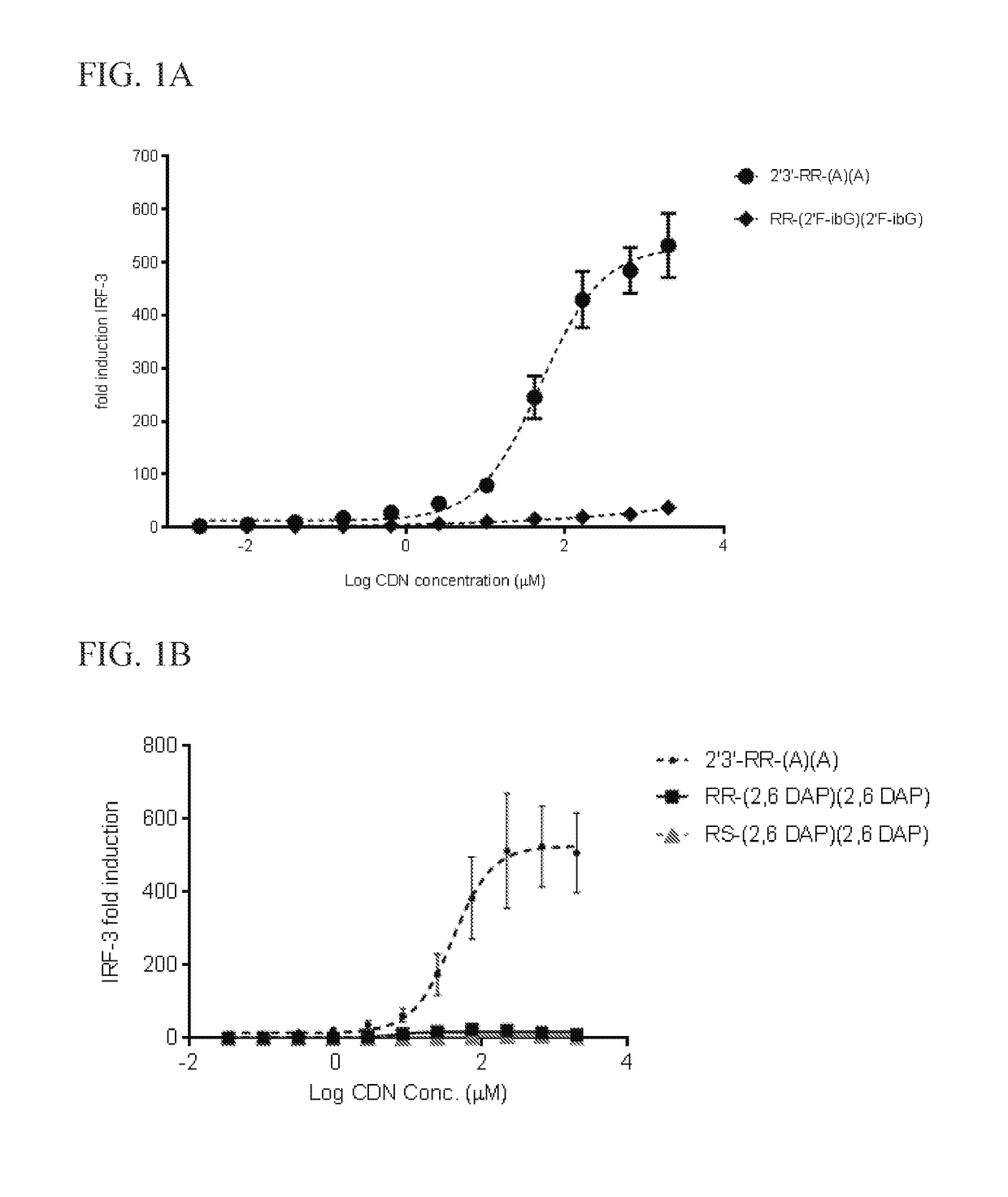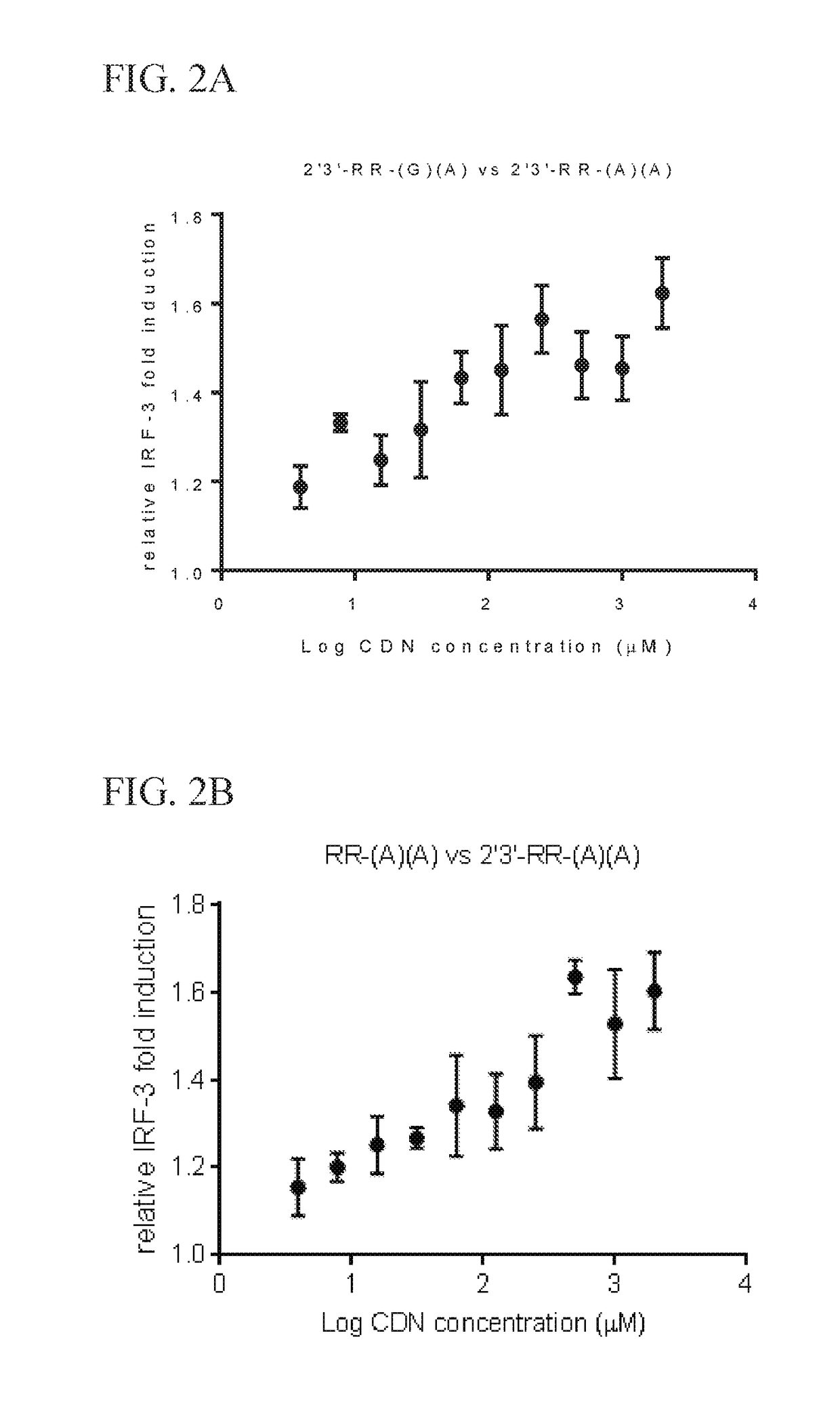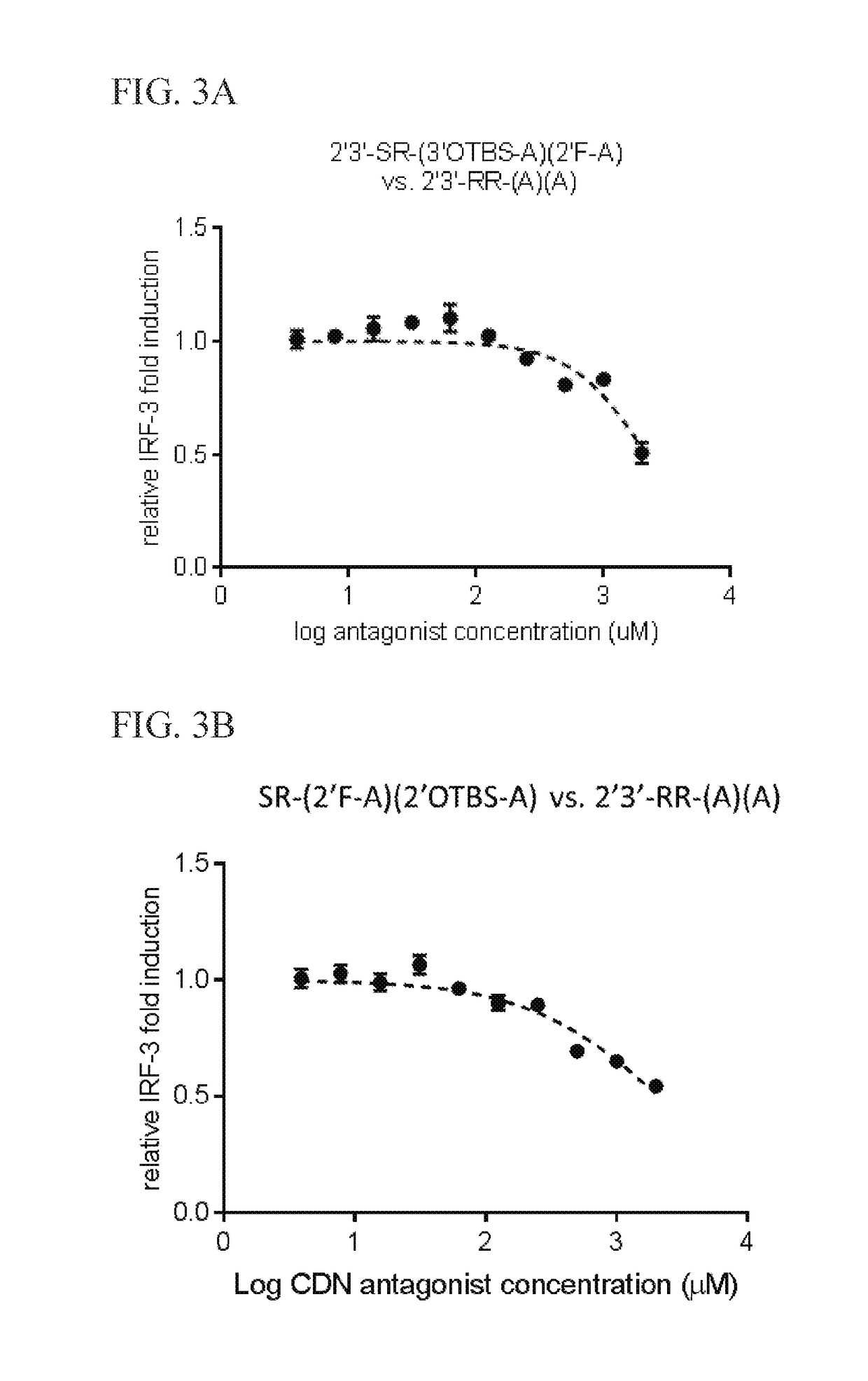Methods for identifying inhibitors of "stimulator of interferon gene"- dependent interferon production
a technology of stimulator and interferon, which is applied in the field of methods for identifying inhibitors of " stimulator of interferon gene"-dependent interferon production, can solve the problems of poor trafficking of generated t cells to malignant cells, poor persistence of induced t cell response,
- Summary
- Abstract
- Description
- Claims
- Application Information
AI Technical Summary
Benefits of technology
Problems solved by technology
Method used
Image
Examples
example 1
of 2′3′-RR-(3′OTBS-A)(2′F-A) (6) and 2′3′-SR-(3′OTBS-A)(2′F-A) (6a)
[0235]2′3′-(3′OTBS-A)(2′F-A) (6), also referred to as dithio-[RP, RP]-cyclic-[3′OTBS-A(2′,5′)p-2′F-A(3′,5′)p], and 2′3′-SR-(3′OTBS-A)(2′F-A) (6a), also referred to as dithio-[SP, RP]-cyclic-[3′OTBS-A(2′,5′)p-2′F-A(3′,5′)p] were prepared as the triethylammonium salts according to the following Scheme 1:
[0236]Step 1: (2R,3R,4R,5R)-5-(6-benzamido-9H-purin-9-yl)-4-fluoro-2-(hydroxymethyl)tetrahydrofuran-3-yl hydrogen phosphonate (2): To a stirring solution of N-(9-((2R,3R,4R,5R)-5-((bis(4-methoxyphenyl)(phenyl)methoxy)methyl)-3-fluoro-4-hydroxytetrahydrofuran-2-yl)-9H-purin-6-yl)benzamide (1, 1.5 g, 2.3 mmol, ChemGenes) in 1,4-dioxane (20 mL) and pyridine (6.7 mL) was added a solution of SalPCl (0.45 g, 2.3 mmol) in 1,4-dioxane (10 mL). After 30 min, to the stirring reaction mixture at room temperature was introduced water (3 mL), and the mixture was poured into a 1N aqueous NaHCO3 solution (60 mL). This aqueous mixture ...
example 2
of 2′3′ RR-(A)(2,6-DAP) (12) and 2′3′-SR-(A)(2,6-DAP) (12a)
[0240]2′3′-RR-(A)(2,6-DAP) 12, also referred to as dithio-[RP, RP]-cyclic-[A(2′,5′)p-2,6-DAP(3′,5′)p] and 2′3′-SR-(A)(2,6-DAP) 12a, also referred to as dithio-[SP, RP]-cyclic-[A(2′,5′)p-2,6-DAP(3′,5′)p], were prepared as the triethylammonium salts according to the following Scheme 2:
[0241]Step 1: (2R,3R,4R,5R)-5-(2,6-bis(2-phenoxyacetamido)-9H-purin-9-yl)-4-((tert-butyldimethylsilyl)oxy)-2-(hydroxymethyl)tetrahydrofuran-3-yl hydrogen phosphonate (8): To a solution of (21R,3R,4R,5R)-5-(2,6-bis(2-phenoxyacetamido)-9H-purin-9-yl)-2-((bis(4-ethoxyphenyl)(phenyl)methoxy)methyl)-4-((tert-buty)dimethylsilyl)oxy)tetrahydrofuran-3-yl (2-cyanoethyl) diisopropylphosphoramidite (7, 0.5 g, 0.43 mmol, ChemGenes) in THF (5.0 mL) and water (20 μL) was added pyridinium trifluoroacetate (0.1 g, 0.52 mmol, 1.2 equiv). After 10 min, to the stirring reaction mixture at room temperature was added tert-butylamine (2.0 mL, 20 mmol). After 10 min, t...
example 3
of RR-(2′F-A)(2′OTBS-A) (18) and SR-(2′F-A)(2′OTBS-A) (8a)
[0245]RR-(2′F-A)(2′OTBS-A) (18), also referred to as dithio-[RP, RP]-cyclic-[2′F-A(3′,5′)p-2′OTBS-A(3′,5′)p] or (2R,3R,3aR,5R,7aR,9R,10R,10aR,12R,14aR)-2,9-bis(6-amino-9H-purin-9-yl)-3-((tert-butyldimethylsilyl)oxy)-10-fluoro-5,12-dimercaptooctahydro-2H,7H-difuro[3,2-d:3′,2′-j][1,3,7,9]tetraoxa[2,8]diphosphacycldodecine 5,12-dioxide, and SR-(2′F-A)(2′OTBS-A) (18a), also referred to as dithio-[SP, RP]-cyclic-[2′F-A(3′,5′)p-2′ OTBS-A(3′,5′)p] or (2R,3R,3aR,5R,7aR,9R,10R,10aR,12S,14aR)-2,9-bis(6-amino-9H-purin-9-yl)-3-((tert-butyldimethylsilyl)oxy)-10-fluoro-5,12-dimercaptooctahydro-2H,7H-difuro[3,2-d:3′,2′-j][1,3,7,9]tetraoxa[2,8]diphosphacyclododecine 5,12-dioxide were prepared as the ammonium salts according to the following Scheme 3:
[0246]Step 1: (2R,3R,4R,5R)-5-(6-benzamido-9H-purin-9-yl)-4-((tert-butyldimethylsilyl)oxy)-2-(hydroxymethyl)tetrahydrofuran-3-yl hydrogen phosphonate (14): To a solution of (21R,3R,4R,5R)-5-(6-be...
PUM
| Property | Measurement | Unit |
|---|---|---|
| Temperature | aaaaa | aaaaa |
| Temperature | aaaaa | aaaaa |
| Molar density | aaaaa | aaaaa |
Abstract
Description
Claims
Application Information
 Login to View More
Login to View More - R&D
- Intellectual Property
- Life Sciences
- Materials
- Tech Scout
- Unparalleled Data Quality
- Higher Quality Content
- 60% Fewer Hallucinations
Browse by: Latest US Patents, China's latest patents, Technical Efficacy Thesaurus, Application Domain, Technology Topic, Popular Technical Reports.
© 2025 PatSnap. All rights reserved.Legal|Privacy policy|Modern Slavery Act Transparency Statement|Sitemap|About US| Contact US: help@patsnap.com



